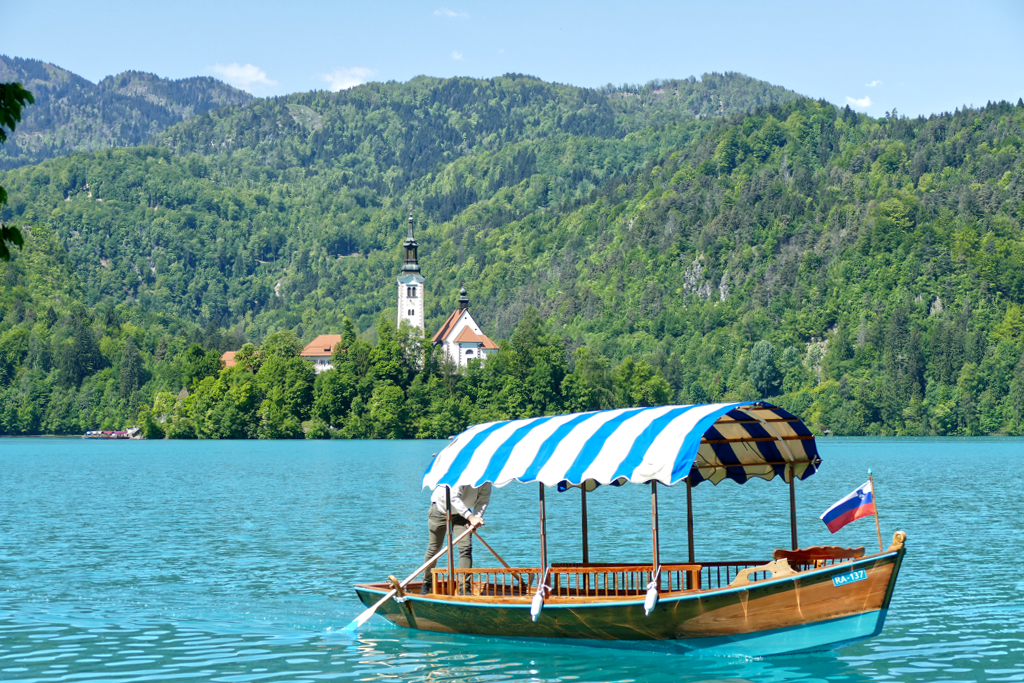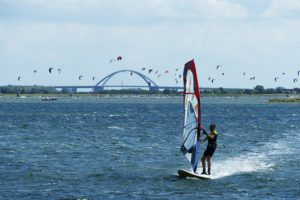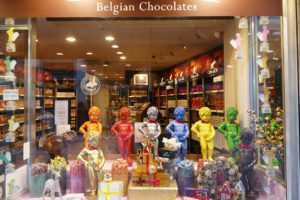Lake Bled is one of those European places of longing. It is one of the sites whose pure name brings a sparkle to the eyes of any day-tripper.
Who hasn’t seen the image of Saint Mary’s Church which seems to float on an island in the middle of the iconic Slovenian lake?
And believe me, this picture is no illusion. These sceneries fulfill their promise of captivating you the moment you lay eyes on them for the first time.
I had the privilege to experience this for myself on a day trip to Lake Bled, which I was actually able to organize myself by taking the public bus from Slovenia’s capital Ljubljana.

A Long-Held Wish Comes True
A couple of years ago when I visited Slovenia on a far too short pit stop while I was on the route to Croatia, the train stopped also in Lesce, the nearest train station serving Bled. I saw the fairy tale sceneries of rolling hills and rugged mountains surrounding the surreal turquoise waters of the lake. Man, was I tempted to grab my bag and hop off!
But instead, I stayed in my seat and looked back longingly as the train continued its journey towards Ljubljana. However, one day I would come back and see for myself that the lake lives up to its myth, namely that it is one of the most beautiful lakes in the world.

(Photo: Mimi Green)
A few days ago, my time had come: I used a long weekend in the capital Ljubljana to also enjoy Slevenia’s charming rural areas and exquisite landscapes. Of course, first and foremost, this included a day trip to Lake Bled.
A Legend
Located near the spa town of Bled at the foot of the Pokljuka Plateau, Lake Bled is in fact surprisingly small. It covers a total area of less than 1.5 square kilometers. As a matter of fact, the Emperors of the Kingdom of Yugoslavia and later the President of the Socialist Republic of Yugoslavia, Josip Broz Tito, had their summer residence in Villa Graščina Grimšce close to this enchanting inland sea.
I’d argue this is just further evidence of the extraordinary magnificence of Lake Bled.
The Island
The image of the small island of Blejski Otok is particularly famous. And rightly so, because strangely enough, this is the only island in all of Slovenia! Although it is not permanently inhabited, the church of Saint Mary attracts many temporary visitors.

The first predecessor of today’s church was consecrated way back in 1142. In the 15th century, it had to be rebuilt in the Gothic style, but was again badly damaged by an earthquake in 1509. Only frescoes in the presbytery and a wooden statue of the Holy Mother were conserved. Apparently, the bell tower also needed to be restored a few times, and in its current form, it is 54 meters high and has three bells.
To get to the church you have to climb 99 steps of a monumental staircase.
In the upper roof above the nave, you will find the so-called wishing bell. Give it a chance and ring it. Who knows, your wish might come true.

Gently down the stream.
Merrily, merrily, merrily, merrily.
Life is but a dream.
The crossing to the island usually takes place in a traditional, hand-made wooden boat called a Pletna, which a so-called Pletnar, an upright rower, navigates across the lake. It’s a bit like the gondoliers in Venice, only fortunately, he doesn’t sing.
Nevertheless, you can also cross by an electric motorboat, but what’s the point?
Taking the Pletna, a return trip costs 14 €uro, and you also have to pay an additional 5 €uro entrance fee to the island. However, this includes access to the church as well as the bell tower.
The Castle
The medieval Bled Castle stands on a 139-meter-high rock above Lake Bled and is considered the oldest castle in Slovenia. Its first mention dates back to the year 1011. The oldest part is the Romanesque tower. Two earthquakes hit the region in 1511 and 1690. This also affected the castle, obviously. The fortification was reinforced and some additional towers were constructed.

The individual structures are arranged around an inner courtyard and connected by stairs. The chapel in the upper courtyard dates from the 16th century. In the 17th century, however, it was restored and frescoed.
Residential buildings are located in the upper part of the courtyard while farm facilities are in the lower part. Among others, today, the castle houses a museum and restaurant.
Like in a fairy tale, a drawbridge spans over a moat in front of the building complex.
The Bled Castle is open every day from 8 a.m. Depending on the season, it closes between 6 p.m. and 8 p.m. The general entrance fee is 17 €uros.
You can walk up to the castle from the waterfront promenade at the Grajsko Kopalisce Lido. The climb takes about twenty minutes.
The Church
In addition to the iconic Saint Mary’s Church, the world-famous landmark of Lake Bled, there are of course other places of worship in the area. The extremely narrow tip of St. Martin’s Church east of Bled Castle peeks out between the treetops in a particularly charming way. It is right on the edge of the village center and, unlike the castle, can be easily reached on a short walk.

Amazingly, the first chapel on the site of today’s Saint Martin’s Church was built before the year 1000! However, today’s neo-Gothic church was only constructed in 1905.
Practical Information
How to Get There And Around
Several buses go to Bled every day, for example from Ljubljana. Some of them continue to Lake Bohinj so that visiting both lakes in a single day is absolutely stress-free, albeit, you probably won’t be able to visit all the attractions Bled has to offer.
To check suitable connections, just type your starting point and the desired destination into Google Maps and the App will give you the best connection.
You can purchase tickets from the bus driver. However, keep in mind that on many buses, you can only pay in cash! A one-way trip from Ljubljana to Bled costs less than 4 €uros per person.
Alternatively, you can get by train to the Lesce-Bled train station. From there, you take the bus to get to the lake or you rent a bike and cycle the 3.5 kilometers.
Once you’re in Bled, you can easily walk around the lake in probably not more than two hours. A great alternative is renting a bike and circumnavigating the lake in an even more comfortable way.
You’ll find a bike rental shop right next to Bled’s bus station.
Visiting Organized
Although I’m an avid solo-travelling woman, I sometimes like to join organized tours. Not only are they a valid option to go to remote places since I’m not driving. They also allow me to enjoy the company of fellow travellers. Tour agencies like GetYourGuide* offer organized tours to Lake Bled at a reasonable price. You can choose between a comprehensive tour of Lake Bled* or a day trip that combines Bled with a visit to Lake Bohinj*. I introduced this amazing inland sea in my post A Day Trip to Lake Bohinj – Where Slovenia is Beautiful And Wild.

Also, here are some more great ideas of what to do when visiting Slovenia. But note that specially during high season, pre-booking online will guarantee your place at the activity of your choice*:
Where to Sleep
As I mentioned, we visited Lake Bled on a day trip during a long weekend in Ljubljana. This being said, I was amazed by the number of hotels in the lake’s vicinity, and I can totally see myself spending an entire, very relaxing weekend around the lake.
Hence, if you are in need of some quiet time amidst Bled’s enchanting beauty, check out suitable lodging options according to your needs and budget on this map*:
What to Eat
I’m not usually one of those people who crave a snack as soon as they arrive at a destination. But we had left Ljubljana quite early and had nothing in our stomachs except some orange juice. We needed coffee and a snack that would fuel us for a hike around the lake.
Luckily, these are two wishes that are very easy to fulfill in Slovenia. Don’t forget that the country shares a common history with Austria and Italy, two of the most famous coffee-drinking nations in the world.
Then, the Balkan influence is reflected in a considerable variety of savory and sweet-filled pastries. The hearty kind is called Burek and is stuffed with different fillings like potatoes, cheese, minced meat, or vegetables. The sweet kind often contains fruit like apples or curd.
Guys, Slovenia is a real paradise for me as a carb lover!

On the way to Bled, we had already researched on the bus where there was a well-rated bakery in town. And I have to say that Pekarna Planika did not disappoint. It was quite a challenge to choose the tastiest pieces from the large selection of delicacies in the showcase in front of us.
Coffee would have been available from a machine. But since the café right next door served it freshly brewed in gourmet quality and we were allowed to eat our baked goodies at their tables, we enjoyed a breakfast fit for Queens!
You can find the Planika bakery, which is just a few minutes from the lake, marked on the map at the end of this post.
Money
Since 2001, 21 European countries have paid with €uros. Slovenia joined the European Union in 2004 and became the first of the new EU countries to adopt the €uro in 2007.
The exchange rate is 1 US$ = 0,85 EUR as of August 2025, but you can check the conversion on this page.
Also, you can pay with credit cards even the smallest amount basically everywhere. However, keep in mind that bus tickets have to be paid in cash most of the time.
Language
Over the past years, Slovenia has become a popular tourist destination. Therefore, many people speak pretty decent English. Older people speak it rather if they are working in the tourist industry, but most young people have a great command of the language. Especially some of the older folks also speak German.
Nevertheless, it puts a smile on people’s faces when you can say at least thank you – hvala – and please and you’re welcome – prosim in Slovenian.
Say It Right
In this post, I’m writing out some of the Slovenian names of brands and places. You should be aware that there are letters that might not exist in other languages.
Most importantly, the letter c is never pronounced as k. It is always pronounced like the ts in Tsar. Hence street is enunciated Ulitsa, not Ulika.
Only when c is written č, it is pronounced like a ch in chachacha.
The same goes for s: written š, it’s pronounced sh. But only then.
Then, there is the letter ž which is pronounced more or less like j, but rather the French way – as in jour.
So now you know how to order your Žganci correctly: Dj-gan-tsi.
People tend to overdo it with the ch and the sh – if there is no accent, it’s a simple c, s, or z, no crackjaw there.
Map
On this map, you can see where to find all the places I’m mentioning in this post. Clicking on the slider symbol at the top left or the full-screen icon at the top right will display the whole map.
Pinnable Pictures
If you choose to pin this post for later, please make sure to use one of these pictures:






Note: This post is being regularly completed, edited, and updated – last in August 2025.
Did You Enjoy This Post? Then You Might Like Also These:
From PORT d’ANDRATX to SANT ELM – Hike With a View
Comprehensive Guide to FLORENCE – Home of the Medici, Cradle of the Renaissance
Best of LISBON – also for solo-travellers
What to See on an Unforgettable Weekend in VILNIUS
24 hours in MUNICH
A VAN-TASTIC TRIP to the ISLAND of FEHMARN
One Day in ARLES – What Not to Miss in Vincent’s Picture-Perfect City
Best Things to Do in BRUSSELS, the Capital of Europe
*This is an affiliate link. If you book through this page, you get the best deal, and I get a small commission that helps me run this blog.
Thank you so much for supporting me!








thank you for this great article about this beautiful lake. very useful for my upcoming trip! keep up the good work!!
Thank you for your kind comment – and enjoy your time in Slovenia 🙂
Pretty! This has been a really wonderful post. Many thanks for providing these details.
Thank you for your kind words – I’m always here to help 🙂 Happy travels!